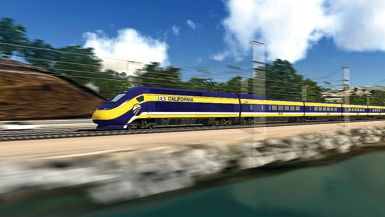Frontline: High-Speed Rail Spurs Economic Development
Q1 2015

This is a controversial issue for several reasons, especially the high cost and eminent domain issues with Central Valley farmers. Proponents cite the long-term construction employment that will result, as well as the economic opportunities for growth along the line.
Fresno Mayor Ashley Swearengin also sees the project as a way to connect the Central Valley to the rest of the state’s economy. “High-speed rail brings attention and focus back to city centers,” she says. “It fills a deficit for Central California. It will be easier for people to live in the middle of the state and do business elsewhere.”
Benefits of High Speed Rail
Economic benefits include construction and operations jobs and manufacturing and supply chain opportunities. More than 25 rail manufacturing companies and suppliers have committed to expanding their U.S. operations if their bids are selected for building high-speed rail systems. For example, Siemens AG has recently purchased land to expand its train-manufacturing operations in Sacramento.
Improving railroad infrastructure has historically resulted in a 6:1 return on investment. According to www.highspeedrailworks.org, “Communities showing significant, demonstrable economic benefits due to rail station construction or renovation include Philadelphia; Davis (California); Meridian (Mississippi); Lafayette (Indiana); Washington, D.C.; Seattle; Milwaukee; and Saco-Biddeford (Maine). The new station in Saco-Biddeford will generate $3.3 billion in construction investment and create more than 8,000 new jobs over the next two decades.”
Millenials (18 to 33 years in age) comprise an influential demographic group that supports high-speed train travel. They are attracted to easy public transit and prefer to live in cities that support public transportation. Therefore, it’s predicted that more millenials will buy homes and invest in communities with high-speed rail.
High-Speed Rail Hotspots
Currently, the only operating high-speed rail line in the U.S. is the Acela, which was introduced by Amtrak in 2000. The train has greatly improved the ease and speed of travel along the Northeast Corridor (Washington, D.C.; Baltimore; Philadelphia; New York; and Boston). However, some of the rail infrastructure along the corridor is deteriorating and needs repair.
There are several other high-speed rail hotspots popping up. Texas Central Railway is an organization intent on building a high-speed rail line (up to 205 mph) that connects Dallas and Houston. An environmental study has been initiated. The Texas project will use the bullet trains popularized in Japan and is planned to open in 2021, according to Richard Lawless, chairman and chief executive of Texas Central Railway.
In Florida, All Aboard Florida wants to construct a high-speed rail line (125 mph) between Miami and West Palm Beach, with a possible extension to Orlando. Planning and preconstruction activities for stations in Miami, West Palm Beach, and Fort Lauderdale are under way. These include a large mixed-use development at the Miami station that will likely stimulate additional economic development in downtown Miami.
Project Announcements
Kraken Technologies Limited Plans New York City Headquarters Operations
12/29/2025
Lupin Expands Coral Springs, Florida, Operations
12/29/2025
KPPC Advanced Chemicals Expands Casa Grande, Arizona, Operations
12/29/2025
Volvo Group Plans Tacoma, Washington, Distribution Operations
12/29/2025
Alnylam Pharmaceuticals Expands Norton, Massachusetts, Operations
12/29/2025
Salvagnini America Expands Hamilton, Ohio, Operations
12/28/2025
Most Read
-
The Workforce Bottleneck in America’s Manufacturing Revival
Q4 2025
-
Rethinking Local Governments Through Consolidation and Choice
Q3 2025
-
Lead with Facts, Land the Deal
Q3 2025
-
Tariff Shockwaves Hit the Industrial Sector
Q4 2025
-
Investors Seek Shelter in Food-Focused Real Estate
Q3 2025
-
America’s Aerospace Reboot
Q3 2025
-
The Permit Puzzle and the Path to Groundbreaking
Q3 2025



